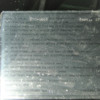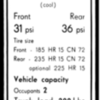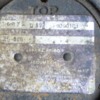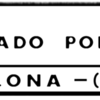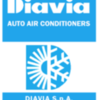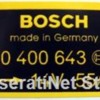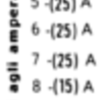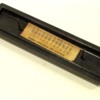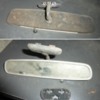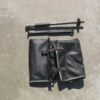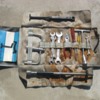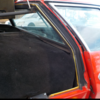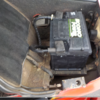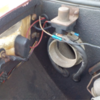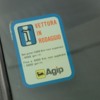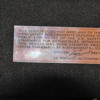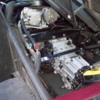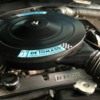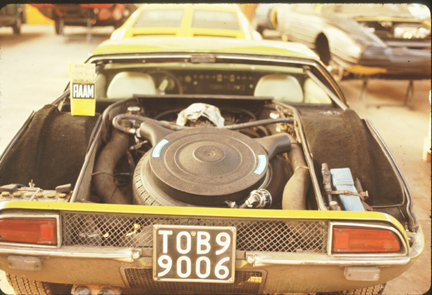http://pantera.infopop.cc/eve/...562/m/4271052056/p/3
http://pantera.infopop.cc/eve/...562/m/4271052056/p/3
On another subject, I spent considerable time resarching Swiss owner Heiko Ostmann's yellow/black Euro-racing Mangusta. It appears in all race reports as a 1967 which is rare enough to start me sniffing around. I found that the vintage racing class he ran in is for '67-'71 cars. But his serial number is reported to be 8MA-1052, which makes it a 1970. Still legal for the class, so dunno where the '67' description came from (if the s.n is correct). He ran 5 international endurance races in 2009 (winning the CSRG GT-1 Championship) and two in 2010, then switched to a sponsored vintage Aston Martin- occasionally, a Porsche Turbo. Only reported Mangusta damage was a broken right rear decklid latch (at Brands Hatch in England?), which at speed popped open and folded the whole assembly over to the center of the car! Caused his only DNF. Must have been messy to fix.
(years later, but some other pictures of Stickers on '1046...) I've seen the air tire pressure on other cars, but on 1046 it was located not only on the glove box but also on the drivers door (8ma978 also has the tire pressure sticker on the door). I've seen one or two of these moved to the inside of the glove box.
Previous owners had really preserved 1046 (esp, the disclaimer stickers on the bulkhead glass and on the windshield (I've only seen the bulkhead sticker on '936, '1006, '1010, 1046), and have never seen another goose with the windshield sticker). The bulkhead sticker was signed "Alberto" on '1046. The date is not shown on '936, but is September 1969 on both '1006/1010 and '1046---I'd believe this was only when the stickers were prepared, I don't think its likely that '1046 was produced in the same month as '1006 (oh, wouldn't it be nice if someone who has the history of DeTomaso would publish it...).
There was not a sticker (such as repo'd by Hall) with warning/disclaimer on the lid to the brake reservoirs on 1046. My guess is that the vin plate (the big aluminum plate Mobil advertisement) started around the late 8ma700's and the sticker on the brake reservoir door came down.
Given the length of preservation, I'd also be inclined to think this Mobil antifreeze decal (anticongelante) was original...
Attachments
...stuck on stickers, here are 2 on the Ayacsa AC box. And plate on the AC compressor Tecumseh HG500 from 8ma1074, and then 8ma1076. Not a surprise that the compressor is out of sequence ('1076 made in April '69 with engine #209 instead of May as for '1074 and engine #201)
Attachments
(just adding more old pictures of '1046...) Showing leather texture on dash and dash cover, as well as different gloss on dash cover. Leather grain is top grain, natural (not smooth, not pebbled). '1046 headliner had been replaced with black pad.
The interior mirror looks so close to Lancia Fulvia series 1 with the stainless or chrome front trim...but is a bit longer and I haven't found another car that uses the same one yet. Note the position of the rivets to the imprint on the back (this pic is from '1076, I clearly haven't restored it yet!). Another close-but-not obsessively-right are the Sunvisors from Fulvia, the mounting points are just a bit different..
Of course the clock worked, and what a coincidence to be photographed at exactly 12:00... ![]()
Jack and jack strap detail, spare hold down shown. The jack was used on Ghibli, the clearest distinction between 'other' jacks is that second knotty nut on the opposite end of the drive; most commonly available jacks have only the 22mm drive nut but the screw on the far end doesn't hang out on the end.
Not shown (but at least on a picture I saw of '1048) the jack strap is secured by a screw thru the carpet on the wheelwell. Note the roller buckle and metal retainer on the strap, same as on the tool roll.
I suppose the hardest question we'll ever answer absolutely is the reason for the jack strap. We've all commonly seen the jack extension tied around the jack with the strap, and Steve has suggested that the tool kit should be here as well (no matter its always displayed in the front trunk, its pretty clear that driving a sports car with a 5 pound item banging around in the trunk would be a distraction...!).
Attachments
Fuse box and relays; fuse box is same as Maserati, but w/their emblem removed. Relays are the Carello 22.900.000...red glop is probably later add.
Cooling fan blade and Lucas motor are same as Pantera...earlier Goose had the square Lucas used on Jag E-type.
Small white fan in front and the rear condenser fan are shared with Maserati QP series I. Motor is on another thread, here apparently a motorcraft blower motor with an exposed shaft (likely a twin blower as on a Mustang heater, with one end cut off!). Bracket is all-thread.
Attachments
Tool kit in 1046...USAG Vanadium Extra spanners (not, Not marked "Durcrom" and with sizes in square boxes at the ends). Earlier Goose had spark plug wrenches with moveable handles (as shown in the parts book), later seemed to have the fixed handle. Missing is the 'small' screwdriver kit, and probably an intruder replacement with yellow handle (though 1048 may have had a similar..?).
Jack extension is pretty special, ~40cm long and note the sleeve. And I'll bet that Manual was original. Just (sniff) wonder where this entire kit was later lost...
Attachments
Picture of the dash, no radio was installed and the hole still covered in leather. Heater knob is sourced from an Austin Mini--or more correctly, the entire heater boss is a modified Mini Innocenti series I box (modified for the intake to come via a 'chimney" from fresh air from the cowl vents instead of the rights side). The motor is not a Smiths, but a maker I can only identify as in Asti, Italy). The hamster wheel fan blade may be common with English Austin Mini or Rover.
Hood mat decoration as used on the trunk on a Ghibli spider.
Note the decorative pattern on the door gaskets. I'd have expected Ghia to use the same weatherstripping between Ghibli and Mangusta, but as I can tell the Goose used something common with Fiat 500 and others and Ghibli weatherstripping becomes the gasket around the rear wheels.
Pedal box cover removed; owner spliced in local Fan relays. Brake reservoirs shared with VW beetle, I hear (and used on early Pantera).
Spanish Ayacsa AC evaporator box is real wood ![]() ,million dollar question is still to understand what pieces were shared with it contemporaneously but it looks like Alfa Spider basically used same Behr design for another 3 decades.
,million dollar question is still to understand what pieces were shared with it contemporaneously but it looks like Alfa Spider basically used same Behr design for another 3 decades.
Attachments
Sneaking in '1074 pictures with details of paint lines, though the car was clearly topcoated at some time, I've seen the blacking across the bulkhead and latch areas before. These kinds of details are just too weird to be applied by anyone but the factory, esp when the bulkhead still has gasket and aged chrome-vinyl edging still in place...note, the area on the front interior edge of the door looks like it was applied with a brush.
Battery pic affirms the booties.
fuel pump is of course a user add...but the undercoating texture, cable clamping and routing here just must be factory.
(Btw, I hate to waste storage by duplicating pictures that were posted on other threads...But hopefully more people see them on this thread...and also thank our kind hosts for what they give us on this Forum!)
Attachments
Lee,
What is that thing off to the side of the jack mount on the 1074 pic???
Regarding the smog valve canister date..... in the Mustang/Ford world the dates on these smog valves seem to have come in batches........and these "batch" dates can spread out widely across production.....where the cast iron and other parts tend to be much closer together.........so don't put too much into any of those dates...... Window and cast iron dates rule!!! ![]()
Nice collection of stickers that I NEVER found anywhere on my car, except for the tin foil list of "don't haves" on the reservoir cover!!! Good stuff!
Those shiny grade 5 bolts holding the headlamp lever to the floor can't be original..... ![]()
Steve
The gold’ing wheels is the clear. I have one where the clear is peeling off and the silver is quite clean. Decals and paint daub is still present.
Denis, so there is a paint daub? ![]() For years I assumed (well like the wheels that I've refinished with "won't yellow" clear before that started to instantly yellow) that the wheels on 1046 were refinished---until noticing last week the original valve stem on the CN72 as the spare...on a 12k mile car. So I'm curious about the paint daub (!) and location of the sticker (esp, were they as carefully applied at 180' from the valve stem as on the pictures of 8ma502) on your wheel.
For years I assumed (well like the wheels that I've refinished with "won't yellow" clear before that started to instantly yellow) that the wheels on 1046 were refinished---until noticing last week the original valve stem on the CN72 as the spare...on a 12k mile car. So I'm curious about the paint daub (!) and location of the sticker (esp, were they as carefully applied at 180' from the valve stem as on the pictures of 8ma502) on your wheel.
The exterior paint on that car was described as an 'old respray' sometime in the 90's on a Google search I found. But I am convinced the paint (if not the Italian pinstripe) was original. Its just impossible to hid a respray without replacing rubber gaskets. Seats had been recovered for sure, I'll bet someone kept the shift knob as a souvenir and intelligent tweaks (esp, adding a redundant wire pull on the engine cover latches) were done by the previous loving owner. But Including things like the bulkhead sticker and tire stickers took real deliberation from someone(s) for 4 decades before my brother got the car. I only know the owner of the car before (Stuart from CO) and next owner (in Atlanta, who had a 4-light red car and apparently traded them both on a Daytona a couple years later when you can see it on BAT). The last time I saw the car, it looked like this...pretty gorgeous. The wheels especially...
Attachments
One more sticker that is fun---the DeTomaso Italian Agip sticker in Italian. This one on a picture of an earlier Goose at Hymans (8ma798), a red-maroon 4 headlight US model (English gauges). The Diavia sticker was found by Johnny W, after trying unsuccessfully to get someone in Ebay/Germany to ship a NOS drier with the sticker attached, I spent a rainy afternoon creating that one dimensionally. The other stickers are ones I have or have photographed...new to this process, the tire pressure sticker took a Lot of a few rainy days...! If anybody has physical access to the bulkhead or tire pressure stickers to provide real measurements, history will give thanks.
Endorsing AGIP might be in conflict with whatever endorsements DeT had with Mobil (as on most of our chassis plates). But there was instead a Shell plate on a few cars ('878 and '982). Go figure.
Oh, Steve, re: dates on the smog stuff---yeah, completely agree, all of this just is curious because it just emphasizes how non-linear the manufacturing process was. It seems there was a commitment and plan for the 400 cars, and parts were made and warehoused. At least one batch of motors was all made in the first 2 weeks in July, 1968, with intakes probably stamped in place at DeTomaso and then randomly put into cars. The bulkhead sticker is typed "September 1969" on this car---but so is the bulkhead sticker on 8ma1008 and September was probably only the date the sticker was made...But that means at least 1 1/2 years between when the smog canister was made and when '1046 was made. Obviously, "Just in Time" was not yet a 3 letter acronym in manufacturing...
Unfortunately for me in 2010 I had other things to worry about and didn't just get details of the motor carb, engine, and castings numbers from '1046. But I have reference points from 2 cars in the ~600 range and '1076 block/intake/heads that suggest a huge batch in that July '68 range...Lee
ps, adding the disclaimer that was used on earlier cars (and is repro'd by Hall) before the bulkhead/windshield sticker...)
Attachments
Lee,
Don't ya hate it when hindsight is better than the foresight????? ![]()
A buncha years back, I had unfettered access to car #508. About 3 miles from my house........I failed badly in taking advantage of this! One day I did go look at the car, the owner had a number of the bits off of the car, special early jackshaft holder, and some others........CRS at the moment..... I thought I had some pictures, but this was likely in the times of no digital camera yet..... or perhaps it was just no camera!!! What I do recall is looking at the dates on a 289 HiPo engine! I believe that they were the latest dates that I had ever seen on such an engine, with either late 67 or early 68 casting dates. They did all line up with the dates on the dual point distributor and the correct hipo carb which was nice to see in that no one had bodgered this thing up with bogus parts yet!
Now the previous owner called this a "67 Goose" but I tried to refute this with simple window dates all showing 1968 manufacturing marks....... "well the body was made in 1967..." is all I got back......!
I was thinking about your date difference......from smog valve to date that 1046 would have been built.....certainly later than April 1968.....! ( I believe that #878 had April 69 window dates largely.)
DeTomaso did a lot of rework to fit the pumps/valves to the cars...new bracketry and hoses... I suspect that these parts were removed from the engines as received from Ford or were shipped separately. ( I never found a large batch of stock Mustang smog pump brackets or water pump pulleys at the factory....doesn't mean they weren't in a dusty old corner....but DeTomaso wasn't fast to throw old parts away....(different story!)....) It would not surprise me that a number of these pumps were stacked away to be installed later/as needed, OR not at all. I am guessing that air pumps were not needed in Europe, and likely these cars received air port plugs in the heads instead of air injection rails......but I haven't had enough exposure to Euro cars to know for sure what was done here. (We need more feedback on air pumps from Europe!) So to have an "older" pump/valve installed on a newer engine wouldn't be out of line......
I can't see DeT leaving an engine (or a partially assembled car) sitting around for a year and a half in light of the production difficulties at Ford's engine plant...... BUT, stranger things have likely happened, including restamping of serial numbers etc......! The true tell, would be the dates on the rest of the engine parts (and windows!) to give us the real story.
I've always advocated owners documenting casting/production dates from the engines and components as well as any dates found stamped into the Girling front/rear brake calipers. A giant spreadsheet of this info would go a LONG way to proving or formulating any theories as you suggest. Just a bugger that we need to build it backwards.... and some dates are just plain hard to get at....!
If there are sequence numbers ie stamped into ZF or engine intake, that would be nice to see also, but I suspect these are more random and couldn't be used to suggest much other than perhaps a "batch".....if they happened to be stamped all at once ie upon receiving them vs sequentially assigned to chassis under production as they rolled off the line??
"Justa inna time-a" was likely more like "whatta we gotta thatta we can use-a!"
"Just get it outta the door!"
Ciao!
Attachments
Lee, thanks for all the great sticker images - - #1046 definitely had some amazing treatment down through the years, when other cars were taking a beating!! Was hoping to provide dimensions for the bulkhead disclaimer sticker but after taking this shot from #1010 I realize the right edge of the sticker has been cut off![]() . Anyway, maybe not surprisingly the stated build date was "Sep 1969".
. Anyway, maybe not surprisingly the stated build date was "Sep 1969".
Here are a few other details from the AC evaporator assy. One blower housing got the red warning label, in what appears to be a consistent position (on it's top, where it can't be seen - - included here for fun only!!) What looks more random is whether that one housing was assembled on the left or right side of the blower motor. As for the last images, I wonder how close the printed serial numbers (here, "520" from 8MA1010 and "780", an unknown leftover /spare from Roland in Germany) follow Mangusta production?! Regards to all, Nate
Attachments
@leea posted:(years later, but some other pictures of Stickers on '1046...) I've seen the air tire pressure on other cars, but on 1046 it was located not only on the glove box but also on the drivers door.
previous owners had really preserved 1046 (esp, the disclaimer stickers on the bulkhead glass and on the windshield (I've only seen the bulkhead sticker on two other cars, '936 and '1008), and have never seen another goose with the windshield sticker). The bulkhead sticker was signed "Alberto" on '1046. The date is not shown on '936, but is September 1969 on both '1008 and '1046---I'd believe this was only when the stickers were prepared, I don't think its likely that '1046 was produced in the same month as '1008 (oh, wouldn't it be nice if someone who has the history of DeTomaso would publish it...).
There was not a sticker (such as repo'd by Hall) with warning/disclaimer on the lid to the brake reservoirs on 1046. My guess is that the vin plate (the big aluminum plate Mobil advertisement) started around the late 8ma700's and the sticker on the brake reservoir door came down.
Given the length of preservation, I'd also be inclined to think this Mobil antifreeze decal (anticongelante) was original...
Hello lee,
I was a little confused about your response on Ebay.
****
Subject: leeaisanut sent a message to De Tomaso Mangusta, Stickers for air filters (De Tomaso Mangusta Stickers) # 143744159640
By: leeaisanut Sent: 10/19/20 6:52 AM
****
Please, don't be piss off :-)
I only wanted to ask in a friendly manner
what participation I can count on, or what the value of this could be.
I also spend a lot of time, which I certainly would not take into account. Only portion of external costs.
I will gladly rework the draft to come as close as possible to the original.
I keep you up to date.
Best regards
![]() I remember Peter Egan writing that the standard pay rate for back yard mechanics is 2 cents per hour. Man, did that Peter have a good gig, either that or he wasn't counting expenses. Anybody supplying parts for the Mangusta should be recognized for their charity...!
I remember Peter Egan writing that the standard pay rate for back yard mechanics is 2 cents per hour. Man, did that Peter have a good gig, either that or he wasn't counting expenses. Anybody supplying parts for the Mangusta should be recognized for their charity...!
If you have a chance, run to Ebay and see the air filter stickers Christian has made, and then look at the picture of the engine bay. Its one thing to have the artistic ability to make something new, its another to be able to make something that is original but looks like it should have always belonged on the car.
If anybody has advice on how to turn artwork to print, I'd love to hear it! Hopefully after the tire pressure sticker, then the Diavia label, then the Ayacsa label, then the bulkhead sticker, then the Tecumseh HG500 label, and lastly the multi-colored "Vin" tag in the trunk--hopefully by then, I'll have a clue! Lee
Hello Lee,
Great to hear, that you like the air filter sticker. I did it ;-)
Enclosed you will see the redone draft of the sticker "Air Tire Pressure".
If their is nothing left to rework, I would start the production.
Should be finished in 2 weeks.
Please stay on ebay...
Best regards
Attachments
Unglaublich schon! Fantastich...
You guys should post pictures here and not rely on eBay....they don't preserve anything but the memory of money parting from your hands......! ![]() ))))
))))
I couldn't find any stickers........but did find all sorts of air filter elements and nonsensical BS.....!!! Stupid suggestion policies......(My opinion only.....)
Ciao!
Steve
Attachments
OK, I'm perplexed..... No where have I ever seen the HP version of the air cleaner decal prior...... doesn't mean that they don't exist....most air cleaner decals are probably dust on the side of the road somewhere.......
More cars seem to have nothing vs "with decals".....
I believe that the first pic is a car at the factory......
Second is the one that I believe Hall was selling a few years ago, perhaps they still are, but it "seemed" like the ones that I had seen on cars prior. OR they were simply decorated along the way. But is seems to be the same color/design as the first one...... PS: This is a "forged" air cleaner that I made up to fit my car with a slightly taller intake.....using an old 68-69 Ford truck version as a base to build on.
SO, where did the HP decal come from, ie when in production based upon SN's seen with this type.
Attachments
Steve, I put this sticker in the category of Nate's carb setup --things that weren't, but maybe should have been ![]() Some brilliantly talented people are piecing together their Mangustas, always fun to see...
Some brilliantly talented people are piecing together their Mangustas, always fun to see...
Yeah, Hall still has repros of the original air cleaner, I just bought my pair a few weeks ago---but just to have around, maybe the originals are Ok (good thing stickers can't rust ![]() ).
).
Somebody correct me, but I don't think the tire pressure sticker has been repro'd before. And every time I think of the crazy, obsessive owners who left these on their glove box, then I wonder where (when now I'm obsessed with putitng them back On) where that leaves me...Lee
....what a gift to us Goose lovers, thanks Christian! Just fabulous...Lee
Christian,
What a BEAUTIFUL car!!! (Hiding behind those stickers!) ![]() )) "Fresh" white is always so damned clean to look at!!!! Nice job on the decals! NONE of the decals on #878, except for the disclaimer on the top of the reservoir cover, survived, or for that matter were ever there!
)) "Fresh" white is always so damned clean to look at!!!! Nice job on the decals! NONE of the decals on #878, except for the disclaimer on the top of the reservoir cover, survived, or for that matter were ever there!
Ciao!
Lee, Edited 7/18 for factual accuracy! S
Regarding pistons in 302s. They were the same for 2V or 4V engines.
(FYI- it is in 1969 in the 351W engines where dished pistons were used in 2V engines vs flat tops for 4V engines!)
The 302 head castings are clearly marked 2V or 4V inside the valve cover area between valve springs, however the valve springs, valve size, camshafts are SHARED 2V and 4V!!!! Surprised me!!!
The 2V and the 4V were otherwise essentially the same engine, but for the intake manifold and perhaps the curve on the distributor! The 4V carb offers a few CFM more than the two barrel version, but the choked down exhaust passages and manifolds continue to be the same..... Only the dual exhaust varies from single. Questionable how much flow the extra pipe really offers......vs the single larger pipe.....in the end!
I think SGC's statement was.....understated. What does a bunch of kids with pencils know....? I don't think they ever figured out a proper "third" write up of this project..... They threw a lot of parts at the car.....but I wonder about the thought process and subsequent execution.
I need to dig out my copies of this writeup and refresh the grey matter!
There is a LOT more potential out of a stocker 68 302! The intake ports are huge and you have a 10.5:1-ish compression ratio with essentially closed chamber heads. The ONLY things holding it back are the puny exhaust ports, which Shelby(?) fixed with the specially ported GT40 heads that were used for LeMans etc, and the dismal low lift camshaft!
Port the exhaust side of the heads mildly, (get rid of the air injection "bump") and put in a HiPo 289 grind cam or bigger, and you have a better breathing small block to play with up to at least the 6000 level RPM's!
Toss in some forged pistons and better rod bolts with that bigger camshaft, and you are rolling now! 400HP is easy. (300 at the rear wheel!)
Ciao!
Steve
Here is the article (series), doing the familiar hot rod tricks (351W heads with bigger valves...). And I'll admit, I just keep looking at the loop on the water valves in the engine bay and wonder if someone just got their Left and Right brackets mixed up (exchanging the brackets orients the exit to the front of the car and avoids the loop...but just one of those things...).
And here (some 10+ years since the question was asked), wow, source photos of that build ...and damn, look, the carb is backwards ![]() https://archive.petersen.org/pages/search.php search on "Tomaso", Mangusta, "1969 AK Miller Engine rebuild," or "1969 British Motor"...starting on the show room at British Motor cars in Anaheim. Lots of tiny details, I'd never noticed the screws for the carpets in the rear wheel wells (but there they are in 8ma1074 also), noted the 2 different designs used for hanging the paper intake tubes (ohm shape on the left, lasso'd on the right), that the asbestos frame was made simply from strap...). Some pictures are pre-engine removal, and I'll bet that the jack shaft was left off for all the track testing using that high rise manifold...the car here in the 8ma700-800 range, I think.
https://archive.petersen.org/pages/search.php search on "Tomaso", Mangusta, "1969 AK Miller Engine rebuild," or "1969 British Motor"...starting on the show room at British Motor cars in Anaheim. Lots of tiny details, I'd never noticed the screws for the carpets in the rear wheel wells (but there they are in 8ma1074 also), noted the 2 different designs used for hanging the paper intake tubes (ohm shape on the left, lasso'd on the right), that the asbestos frame was made simply from strap...). Some pictures are pre-engine removal, and I'll bet that the jack shaft was left off for all the track testing using that high rise manifold...the car here in the 8ma700-800 range, I think.


